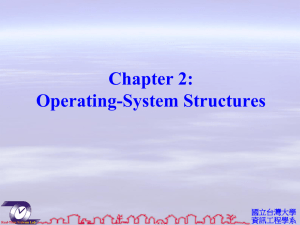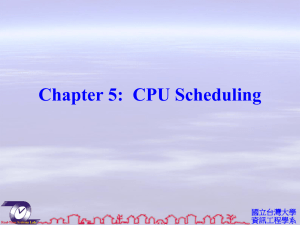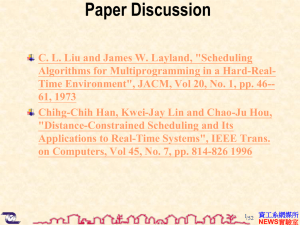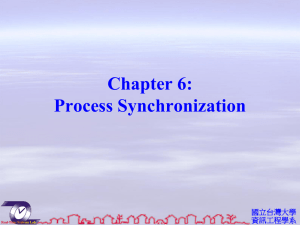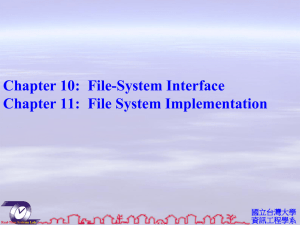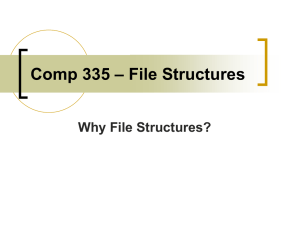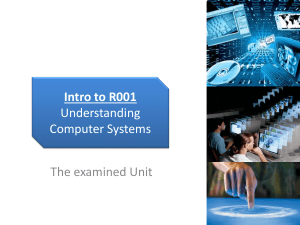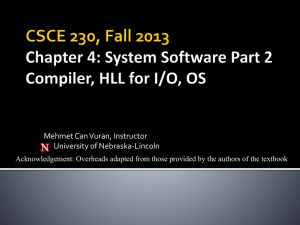資工系網媒所NEWS實驗室Chapter 13
advertisement
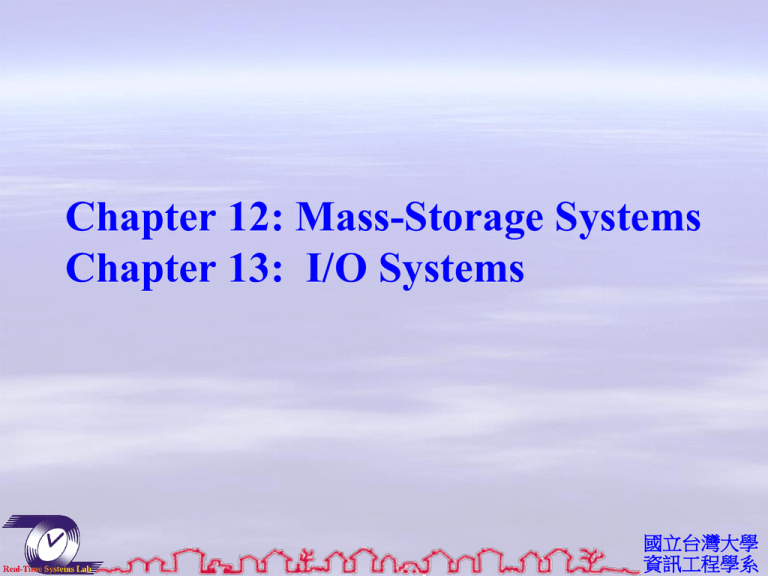
Chapter 12: Mass-Storage Systems Chapter 13: I/O Systems 國立台灣大學 資訊工程學系 Chapter 12: Mass-Storage Systems Operating System Concepts – 8th Edition, Silberschatz, Galvin and Gagne ©2009 Objectives To describe the physical structure of secondary storage devices and its effects on the uses of the devices To explain the performance characteristics of mass-storage devices To evaluate disk scheduling algorithms. To discuss operating-system services provided for mass storage, including RAID. 資工系網媒所 NEWS實驗室 Chapter 12: Mass-Storage Systems Overview of Mass Storage Structure Disk Structure Disk Attachment Disk Scheduling Disk Management Swap-Space Management RAID Structure Stable-Storage Implementation 資工系網媒所 NEWS實驗室 Overview of Mass Storage Structure Magnetic disks provide bulk of secondary storage of modern computers Drives rotate at 60 to 200 times per second Transfer rate is rate at which data flow between drive and computer Positioning time (random-access time) is time to move disk arm to desired cylinder (seek time) and time for desired sector to rotate under the disk head (rotational latency) Head crash results from disk head making contact with the disk surface That’s bad Disks can be removable Drive attached to computer via I/O bus Busses vary, including EIDE, ATA, SATA, USB, Fibre Channel, SCSI Host controller in computer uses bus to talk to disk controller built into drive or storage array 資工系網媒所 NEWS實驗室 Moving-head Disk Mechanism 資工系網媒所 NEWS實驗室 Overview of Mass Storage Structure (Cont.) Magnetic tape Was early secondary-storage medium Relatively permanent and holds large quantities of data Access time slow Random access ~1000 times slower than disk Mainly used for backup, storage of infrequently-used data, transfer medium between systems Kept in spool and wound or rewound past read-write head Once data under head, transfer rates comparable to disk 20-200GB typical storage Common technologies are 4mm, 8mm, 19mm, LTO-2 and SDLT 資工系網媒所 NEWS實驗室 LTO (Linear Tape-Open) 7 /65 資工系網媒所 NEWS實驗室 SDLT (Super Digital Linear Tape) 8 /65 資工系網媒所 NEWS實驗室 9 /65 資工系網媒所 NEWS實驗室 Disk Structure Disk drives are addressed as large 1-dimensional arrays of logical blocks, where the logical block is the smallest unit of transfer. The 1-dimensional array of logical blocks is mapped into the sectors of the disk sequentially. Sector 0 is the first sector of the first track on the outermost cylinder. Mapping proceeds in order through that track, then the rest of the tracks in that cylinder, and then through the rest of the cylinders from outermost to innermost. 資工系網媒所 NEWS實驗室 Disk Attachment Host-attached storage accessed through I/O ports talking to I/O busses SCSI itself is a bus, up to 16 devices on one cable, SCSI initiator requests operation and SCSI targets perform tasks Each target can have up to 8 logical units (disks attached to device controller FC is high-speed serial architecture Can be switched fabric with 24-bit address space – the basis of storage area networks (SANs) in which many hosts attach to many storage units Can be arbitrated loop (FC-AL) of 126 devices 資工系網媒所 NEWS實驗室 Network-Attached Storage Network-attached storage (NAS) is storage made available over a network rather than over a local connection (such as a bus) NFS and CIFS are common protocols Implemented via remote procedure calls (RPCs) between host and storage New iSCSI protocol uses IP network to carry the SCSI protocol 資工系網媒所 NEWS實驗室 Storage Area Network Common in large storage environments (and becoming more common) Multiple hosts attached to multiple storage arrays - flexible 資工系網媒所 NEWS實驗室 Disk Scheduling The operating system is responsible for using hardware efficiently — for the disk drives, this means having a fast access time and disk bandwidth. Access time has two major components Seek time is the time for the disk are to move the heads to the cylinder containing the desired sector. Rotational latency is the additional time waiting for the disk to rotate the desired sector to the disk head. Minimize seek time Seek time seek distance Disk bandwidth is the total number of bytes transferred, divided by the total time between the first request for service and the completion of the last transfer. 資工系網媒所 NEWS實驗室 Disk Scheduling (Cont.) Several algorithms exist to schedule the servicing of disk I/O requests. We illustrate them with a request queue (0-199). 98, 183, 37, 122, 14, 124, 65, 67 Head pointer 53 資工系網媒所 NEWS實驗室 FCFS Illustration shows total head movement of 640 cylinders. 資工系網媒所 NEWS實驗室 SSTF Selects the request with the minimum seek time from current head position. SSTF is a form of SJF scheduling; may cause starvation of some requests. Illustration shows total head movement of 236 cylinders. 資工系網媒所 NEWS實驗室 SCAN The disk arm starts at one end of the disk, and moves toward the other end, servicing requests until it gets to the other end of the disk, where the head movement is reversed and servicing continues. Sometimes called the elevator algorithm. Illustration shows total head movement of 208 cylinders. 資工系網媒所 NEWS實驗室 C-SCAN Provides a more uniform wait time than SCAN. The head moves from one end of the disk to the other. servicing requests as it goes. When it reaches the other end, however, it immediately returns to the beginning of the disk, without servicing any requests on the return trip. Treats the cylinders as a circular list that wraps around from the last cylinder to the first one. 資工系網媒所 NEWS實驗室 C-LOOK Version of C-SCAN Arm only goes as far as the last request in each direction, then reverses direction immediately, without first going all the way to the end of the disk. 資工系網媒所 NEWS實驗室 Selecting a Disk-Scheduling Algorithm SSTF is common and has a natural appeal SCAN and C-SCAN perform better for systems that place a heavy load on the disk. Performance depends on the number and types of requests. Requests for disk service can be influenced by the fileallocation method. The disk-scheduling algorithm should be written as a separate module of the operating system, allowing it to be replaced with a different algorithm if necessary. Either SSTF or LOOK is a reasonable choice for the default algorithm. 資工系網媒所 NEWS實驗室 Disk Management Low-level formatting, or physical formatting — Dividing a disk into sectors that the disk controller can read and write. To use a disk to hold files, the operating system still needs to record its own data structures on the disk. Partition the disk into one or more groups of cylinders. Logical formatting or “making a file system”. Boot block initializes system. The bootstrap is stored in ROM. Bootstrap loader program. Methods such as sector sparing used to handle bad blocks. 資工系網媒所 NEWS實驗室 Booting from a Disk in Windows 2000 資工系網媒所 NEWS實驗室 Swap-Space Management Swap-space — Virtual memory uses disk space as an extension of main memory. Swap-space can be carved out of the normal file system, or, more commonly, it can be in a separate disk partition. Swap-space management 4.3BSD allocates swap space when process starts; holds text segment (the program) and data segment. Kernel uses swap maps to track swap-space use. Solaris 2 allocates swap space only when a page is forced out of physical memory, not when the virtual memory page is first created. 資工系網媒所 NEWS實驗室 Data Structures for Swapping on Linux Systems 資工系網媒所 NEWS實驗室 RAID Structure RAID – multiple disk drives provides reliability via redundancy. RAID is arranged into six different levels. Several improvements in disk-use techniques involve the use of multiple disks working cooperatively. Disk striping uses a group of disks as one storage unit. RAID schemes improve performance and improve the reliability of the storage system by storing redundant data. Mirroring or shadowing keeps duplicate of each disk. Block interleaved parity uses much less redundancy. 資工系網媒所 NEWS實驗室 RAID Levels 資工系網媒所 NEWS實驗室 RAID (0 + 1) and (1 + 0) 資工系網媒所 NEWS實驗室 Extensions The concepts of RAID have been generalized to Array of tapes Recover if one is damaged. Broadcast of data over wireless systems. Reconstructed if one is lost. THE InServ Storage Array Each disk is broken into 256-MB chunklets. A chunklet might be used for multiple volumes. RAID is applied at the chunklet level. Utility Storage Allocated when used. 29 /65 資工系網媒所 NEWS實驗室 Problem Wrong file pointers, incomplete write, … ZFS (solaris), maintain internal checksum of all blocks. Lack of flexibility Big vs little volumes Pool of storage (ZFS) 30 /65 資工系網媒所 NEWS實驗室 Stable-Storage Implementation Write-ahead log scheme requires stable storage. To implement stable storage: Replicate information on more than one nonvolatile storage media with independent failure modes. Update information in a controlled manner to ensure that we can recover the stable data after any failure during data transfer or recovery. 資工系網媒所 NEWS實驗室 End of Chapter 12 Operating System Concepts – 8th Edition, Silberschatz, Galvin and Gagne ©2009 Chapter 13: I/O Systems Operating System Concepts – 8th Edition, Silberschatz, Galvin and Gagne ©2009 Objectives To explore the structure of an operating system’s I/O subsystem To discuss the principles and complexity of I/O hardware To explain the performance aspects of I/O hardware and software 資工系網媒所 NEWS實驗室 Chapter 13: I/O Systems I/O Hardware Application I/O Interface Kernel I/O Subsystem Transforming I/O Requests to Hardware Operations Streams Performance 資工系網媒所 NEWS實驗室 I/O Hardware Incredible variety of I/O devices Common concepts Port Bus (daisy chain or shared direct access) Controller (host adapter) I/O instructions control devices Devices have addresses, used by Direct I/O instructions Memory-mapped I/O 資工系網媒所 NEWS實驗室 A Typical PC Bus Structure 資工系網媒所 NEWS實驗室 Device I/O Port Locations on PCs (partial) 資工系網媒所 NEWS實驗室 Polling Determines state of device command-ready busy Error Busy-wait cycle to wait for I/O from device 資工系網媒所 NEWS實驗室 Interrupts CPU Interrupt-request line triggered by I/O device Interrupt handler receives interrupts Maskable to ignore or delay some interrupts Interrupt vector to dispatch interrupt to correct handler Based on priority Some nonmaskable Interrupt mechanism also used for exceptions 資工系網媒所 NEWS實驗室 Interrupt-Driven I/O Cycle 資工系網媒所 NEWS實驗室 Intel Pentium Processor Event-Vector Table 資工系網媒所 NEWS實驗室 Direct Memory Access Used to avoid programmed I/O for large data movement Requires DMA controller Bypasses CPU to transfer data directly between I/O device and memory 資工系網媒所 NEWS實驗室 Six Step Process to Perform DMA Transfer 資工系網媒所 NEWS實驗室 Application I/O Interface I/O system calls encapsulate device behaviors in generic classes Device-driver layer hides differences among I/O controllers from kernel Devices vary in many dimensions Character-stream or block Sequential or random-access Sharable or dedicated Speed of operation read-write, read only, or write only 資工系網媒所 NEWS實驗室 A Kernel I/O Structure 資工系網媒所 NEWS實驗室 Characteristics of I/O Devices 資工系網媒所 NEWS實驗室 Block and Character Devices Block devices include disk drives Commands include read, write, seek Raw I/O or file-system access Memory-mapped file access possible Character devices include keyboards, mice, serial ports Commands include get, put Libraries layered on top allow line editing 資工系網媒所 NEWS實驗室 Network Devices Varying enough from block and character to have own interface Unix and Windows NT/9x/2000 include socket interface Separates network protocol from network operation Includes select functionality Approaches vary widely (pipes, FIFOs, streams, queues, mailboxes) 資工系網媒所 NEWS實驗室 Clocks and Timers Provide current time, elapsed time, timer Programmable interval timer used for timings, periodic interrupts ioctl (on UNIX) covers odd aspects of I/O such as clocks and timers 資工系網媒所 NEWS實驗室 Blocking and Nonblocking I/O Blocking - process suspended until I/O completed Easy to use and understand Insufficient for some needs Nonblocking - I/O call returns as much as available User interface, data copy (buffered I/O) Implemented via multi-threading Returns quickly with count of bytes read or written Asynchronous - process runs while I/O executes Difficult to use I/O subsystem signals process when I/O completed Vectored I/O - scatter-gather, readv, writev 資工系網媒所 NEWS實驗室 Two I/O Methods Synchronous Asynchronous 資工系網媒所 NEWS實驗室 Kernel I/O Subsystem Scheduling Some I/O request ordering via per-device queue Some OSs try fairness Buffering - store data in memory while transferring between devices To cope with device speed mismatch Double buffering To cope with device transfer size mismatch To maintain “copy semantics” 資工系網媒所 NEWS實驗室 Device-status Table 資工系網媒所 NEWS實驗室 Sun Enterprise 6000 Device-Transfer Rates 資工系網媒所 NEWS實驗室 Kernel I/O Subsystem Caching - fast memory holding copy of data Always just a copy Key to performance Spooling - hold output for a device If device can serve only one request at a time i.e., Printing Device reservation - provides exclusive access to a device System calls for allocation and deallocation Watch out for deadlock 資工系網媒所 NEWS實驗室 Error Handling OS can recover from disk read, device unavailable, transient write failures Most return an error number or code when I/O request fails System error logs hold problem reports 資工系網媒所 NEWS實驗室 I/O Protection User process may accidentally or purposefully attempt to disrupt normal operation via illegal I/O instructions All I/O instructions defined to be privileged I/O must be performed via system calls Memory-mapped and I/O port memory locations must be protected too 資工系網媒所 NEWS實驗室 Use of a System Call to Perform I/O 資工系網媒所 NEWS實驗室 Kernel Data Structures Kernel keeps state info for I/O components, including open file tables, network connections, character device state Many, many complex data structures to track buffers, memory allocation, “dirty” blocks Some use object-oriented methods and message passing to implement I/O 資工系網媒所 NEWS實驗室 UNIX I/O Kernel Structure 資工系網媒所 NEWS實驗室 I/O Requests to Hardware Operations Consider reading a file from disk for a process: Determine device holding file Translate name to device representation Physically read data from disk into buffer Make data available to requesting process Return control to process 資工系網媒所 NEWS實驗室 Life Cycle of An I/O Request 資工系網媒所 NEWS實驗室 STREAMS STREAM – a full-duplex communication channel between a user-level process and a device in Unix System V and beyond A STREAM consists of: STREAM head interfaces with the user process driver end interfaces with the device zero or more STREAM modules between them. Each module contains a read queue and a write queue Message passing is used to communicate between queues 資工系網媒所 NEWS實驗室 The STREAMS Structure 資工系網媒所 NEWS實驗室 Performance I/O a major factor in system performance: Demands CPU to execute device driver, kernel I/O code Context switches due to interrupts Data copying Network traffic especially stressful 資工系網媒所 NEWS實驗室 Intercomputer Communications 資工系網媒所 NEWS實驗室 Improving Performance Reduce number of context switches Reduce data copying Reduce interrupts by using large transfers, smart controllers, polling Use DMA Balance CPU, memory, bus, and I/O performance for highest throughput 資工系網媒所 NEWS實驗室 Device-Functionality Progression 資工系網媒所 NEWS實驗室 End of Chapter 13 Operating System Concepts – 8th Edition, Silberschatz, Galvin and Gagne ©2009

